

What is CRISPR? How to make a linkage map based on phenotype of offspring - Restoring the American chestnut. The sunlight glimmers through the leaves of a healthy American chestnut tree in Pennsylvania.
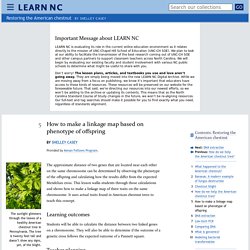
The tree is twenty feet tall and doesn’t show any signs, yet, of the blight. The approximate distance of two genes that are located near each other on the same chromosome can be determined by observing the phenotype of the offspring and calculating how the results differ from the expected Mendelian cross. This lesson walks students through those calculations and shows how to make a linkage map of three traits on the same chromosome. It uses actual traits found in American chestnut trees to teach this concept. Learning outcomes Students will be able to calculate the distance between two linked genes on a chromosome. Teacher planning Time required 45 minutes Materials needed calculators rulers overhead projector If completing the optional activity you will also need three beads and one pipe cleaner per student.
Technology resources Each student will need his or her own calculator. Student handouts Activity. Popped Secret: The Mysterious Origin of Corn. Hhmi. A hands-on activity in which students apply the principles of Mendelian genetics to analyze the results of genetic crosses between stickleback fish with different traits.

Students use photos of actual research specimens (the F1 and F2 cards) to obtain their data; they will then analyze the data they collected along with additional data from the scientific literature. In the extension activity, students use chi-square analysis to determine the significance of genetic data. Appropriate for: high school biology (all levels) Note: This lab was published April 2013 and updated May 2015 to incorporate feedback from field testers.
Understanding Genetics. Understanding Genetics. -A high school student from Illinois December 20, 2006 Video Answer about why everyone in a family has blue eyes except mom.

Meiosis and Mendel's Law. Random Orientation of Chromosomes During Meiosis. Pleiotropy Is Not Polygenic Inheritance. Genetics Unit. Reality Rears Its Head There are Many Shades of Brown There Are Always Multiple Alleles Genetic inheritance is often presented with straightforward examples involving only two alleles, one of which is dominant over the other.
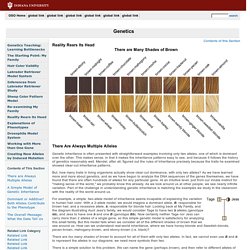
This makes sense, in that it makes the inheritance patterns easy to see, and because it follows the history of genetics reasonably well. Mendel, after all, figured out the rules of inheritance precisely because the traits he examined showed clear-cut inheritance patterns. But, how many traits in living organisms actually show clear-cut dominance, with only two alleles? For example, a simple, two-allele model of inheritance seems incapable of explaining the variation in human hair color. Human Eye Color Chart, With Fun Facts. By Marilyn Haddrill; illustration by Stephen Bagi Human eye color charts once were used to "predict" eye colors of children.
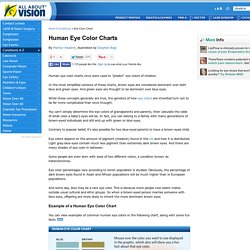
In the most simplified versions of these charts, brown eyes are considered dominant over both blue and green eyes. And green eyes are thought to be dominant over blue eyes. While these concepts generally are true, the genetics of how eye colors are inherited turn out to be far more complicated than once thought. You can't simply determine the eye colors of grandparents and parents, then calculate the odds of what color a baby's eyes will be. Contrary to popular belief, it's also possible for two blue-eyed parents to have a brown-eyed child. What Color Eyes will your Children Have?
3413_genes.pdf. Did The Hemophilia Gene Reach Queen Victoria From Nathan Mayer Rothschild? The children of Tsar Nicholas.

Alexei the only son had hemophilia. All were granchildren of Queen Victoria. Haemophilia spread into many of Europe’s Royal families from her. But how did she get the gene? It did not exist in her official parents’ families. The arrival of hemophilia amongst Europe’s Royal families, when Queen Victoria gave birth to a hemophiliac son, shocked everyone. Prince Albert, the son of a stable lad called Henstein, and the father of most of Queen Victoria’s brood, if not all, was also illegitimate and not a Coburg-Gotha at all. The question as to who Queen Victoria’s father was appears the key to where the illness came from. Genetics - Mrs. E's Biology Site.
In this unit, we will be studying Molecular Genetics (DNA & Protein Synthesis) and Mendelian Genetics (all those Punnet squares you know and love!).
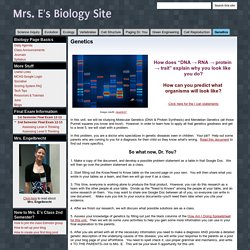
However, in order to learn how to apply all that genetics goodness and get to a level 5, we will start with a problem. Genetics PBL Problem: Part I - Google Docs. Sweet_baby.pdf. No, I’m Not Irish. Animation - Mendel's Laws of Genetics. Bf10901.pdf. In Hopes Of Fixing Faulty Genes, One Scientist Starts With The Basics. Jennifer Doudna and her colleagues found an enzyme in bacteria that makes it much easier to edit DNA in animal cells.
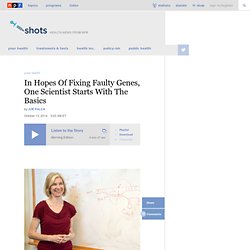
Cailey Cotner/UC Berkeley hide caption itoggle caption Cailey Cotner/UC Berkeley Jennifer Doudna and her colleagues found an enzyme in bacteria that makes it much easier to edit DNA in animal cells. Cailey Cotner/UC Berkeley Whether they admit it or not, many (if not most) scientists secretly hope to get a call in October informing them they've won a Nobel Prize. But I've talked to a lot of Nobel laureates, and they are unanimous on one point: None of them pursued a research topic with the intention of winning the prize.
That's certainly true for Jennifer Doudna. The idea came when she and her colleagues at the University of California, Berkeley, were in essence trying to figure out how bacteria fight the flu. Sciencecases.lib.buffalo.edu/cs/files/sweet_baby.pdf. Science Outreach. Why Women Are Stripey.